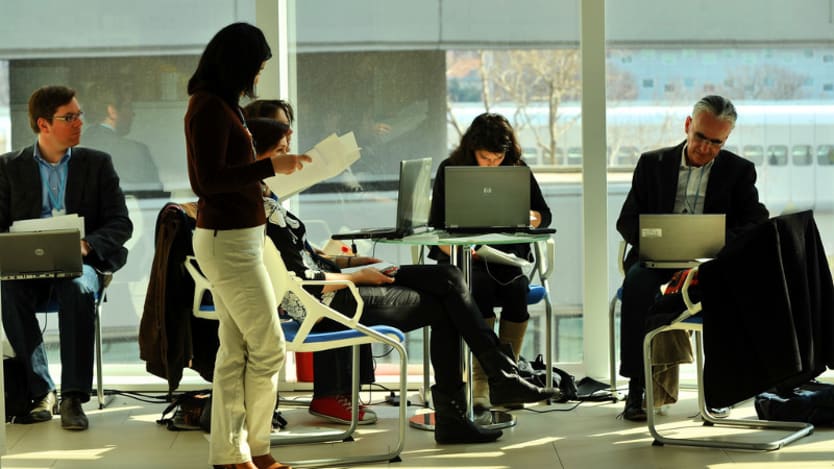
CANBERRA — Gender parity in humanitarian media remains an elusive goal when it comes to both sources and reporters, new research by the Humanitarian Advisory Group concludes.
The paper, “Women’s voice in humanitarian media. No surprises,” was presented March 8 at a Melbourne forum where media teams from humanitarian NGOs discussed how to better enable female voices in the media — an important tool to influence social change. In attendance were groups such as CARE Australia and Save the Children, as well as independent researchers, and staffers from Department of Foreign Affairs and Trade. Participants contributed to building awareness of the issues — and identifying steps organizations can take enable change.
The findings of the report
Within the media, the report found that female authors were more likely to quote female sources. Looking into humanitarian articles produced by Al Jazeera over a four-week period in Oct. 2017, they found that females wrote 51 percent of articles. Other specialized media outlets, which were not named in the report, had a lower authorship from women at 39 percent.
As sources contributing to articles, women contributed to less than a quarter of the expert voices.
But the report notes that this is a widespread trend in media — even in countries such as Finland, which is considered progressive for gender equality.
Kate Sutton, director of the Humanitarian Advisory Group, explained to Devex that the report generated a surprised response from the Australian sector with some commenting that they had not been aware of the issue.
“And that’s really helpful,” she said. “Those moments when the penny drops.”
At the forum in Melbourne, the Humanitarian Advisory Group actively sought both male and female representatives to ensure the discussion is made an organization wide issue to tackle — and not just an issue for women.
Discussing the causes of underrepresentation of women
Q&A: Humanitarian Advisory Group explains how NGOs can push for gender equality at the top
New research from the Humanitarian Advisory Group identifies an important gap in achieving equal representation at the top of NGOs: data. Devex speaks to Kate Sutton, director of the Humanitarian Advisory Group, about this new research and who needs to be involved in discussions to create change at the top of NGOs.
Though women tend to make up a large percentage of the humanitarian workforce, at the top the numbers shift in favor of men, Sutton explained. In promoting their organization, humanitarian groups’ media teams will often put forward an interview or comments from staff higher up. And if the top is male dominated, the resulting media coverage reflects this trend.
But the forum also identified that there was a confidence gap between men and women when they were approached by the media, with women more likely to say that they are not an expert or need time to think about contributing to an article.
“And that is contributing to the gap also,” Sutton said. “But even this was not something media teams within organizations were aware of, women need to feel confident to engage and speak on humanitarian issues and not all do.”
Ideas to change the statistics
Among humanitarian agencies in particular, a suggestion from CARE Australia was to build media and communications into the localization agenda: While planning and preparing for natural disasters, groups can simultaneously identify and train local female experts who could be tapped to provide comment following a disaster.
Participants also highlighted the need to train and provide support to build confidence of female staff within organizations — as well as identify experts lower on the organizational rung to build their visibility, confidence, and change to build leadership capability. And ensuring media units are putting female experts forward is critical in creating change.
Building tools that help the media identify experts in the field was also suggested through the potential development of an online database of female humanitarian leaders for interview or comment, similar to the Women’s Leadership Institute Australia’s Women for Media initiative.
Educating organizations is important in creating change, but so too is drawing attention to the issue among the media.
In a 2014 study by the Australian Broadcasting Corporation on gender representation within their own reporting, Australia’s national broadcaster found that across television, radio, and online, 80 percent of interview time was dedicated to men. But, within 12 months of the report release, female representation increased to 26 percent of content. And the director of news attributed this directly to being aware that the bias existed.
Next stages of work
For the Humanitarian Advisory Group, the report is the first stage in work to create gender parity in humanitarian media with the group hoping to look at more sources and more analysis — including how women are portrayed.
“In many ways, this represents a baseline for us so we know what is happening,” Sutton explained. “It forms part of a research stream we are doing on diverse leadership in humanitarian action. We have a funded research program with DFAT and we are looking at this as part of one of those research streams.”
And at the forum, participants discussed the need to unpack the issues further through better research and ways that organizations might be supported to enable change — demonstrating that representation in media may become an issue for foreign aid.
Editorial note: The author contributed comments to the Humanitarian Advisory Group supporting the development of their report and this article was updated to protect the Chatham House rules of the meeting.








